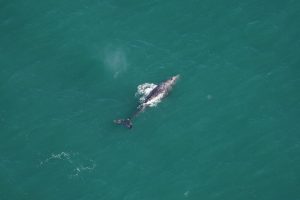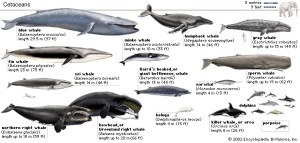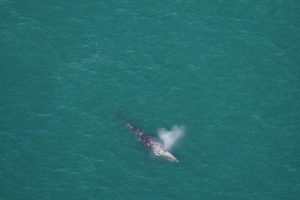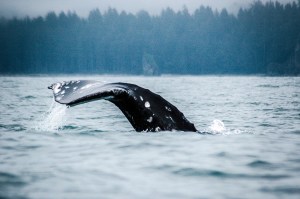Endangered Gray Whale spotted in New England!
An Exciting, but Potentially Troubling, First Sighting

Gray Whales were once common in New England waters – photo courtesy of New England Aquarium
The New England Aquarium’s Anderson Cabot Center for Ocean Life aerial transect research team recorded a grey whale feeding 30 miles off of Nantucket this week, the first time this species has been seen in New England since it was hunted to local extinction over 200 years ago. Today, grey whales are usually only found in the north Pacific, and this marks only the fifth time they have been observed outside of that range.
While this sighting is exciting, and could mean that grey whale populations are increasing, leading to greater dispersal, it is also troubling. That’s because this grey whale was likely able to make it to the Atlantic ocean via the “northwest passage” through the Arctic, which in recent years has become entirely ice free in the summer for the first time in recorded history. This, and other climatic changes, are likely factors in other recent sightings of Pacific species on the coast of New England and Maritime Canada, such as the stellar’s sea eagle and tufted puffin which excited birders over the last few years.

Gray whales are a mid sized baleen whale. Here they are compared to humans, elephants, and other whales. Courtesy of Encyclopedia Britannica
What do we know about this Gray Whale?
Not much! At this time, additional details about the whale such as it’s sex, age, or when it first entered Atlantic waters, are unknown.
Grey whales are able to cover massive distances in a relatively short period of time. They swim a round trip of 12,000 miles each year to move from their feeding to breeding grounds and back again. A sighting of a gray whale was made off the coast of Florida in December, and it is believed by researchers that this is the same whale who was spotted earlier this week.
Will the whale come to the Gulf of Maine?
We can’t know! Because gray whales can cover such huge distances and frequently spend large amounts of time outside of social groups, they can be very difficult to track. The gray whale’s preference for shallow water, compared to other Maine species such as the humpback and finback, means that if it does enter the Gulf it will likely travel closer to shore than is common for similarly sized whales.
Let’s learn about Gray Whales!

Grey Whales have a distinctive heart shaped spout – photo courtesy of the New England Aquarium
- Gray whales typically prefer shallow waters near to shore (relative for a whale) where they roll through sea floor mud in order to disturb amphipods and other ocean invertebrates.
- Gray whales are baleen whales, meaning they have bristle like tooth structures which they use to filter food out of the water and sediment.
- Gray whales are similar in size to the humpback and right whales more commonly spotted in the Gulf of Maine, growing to an average length of 45 feet and a weight of 90,000 pounds.
- One thing that makes gray whales stand out from other whales is their lack of a dorsal (back) fin. Instead, they have a hump 2/3 down the length of their body, followed by a series of “knuckle” bumps extending towards the tail.
- Gray whales are known for being curious and unafraid towards whale watching boats, earning them the nickname “friendly ones”. This is especially true in the calving grounds of the San Ignacio lagoon in Baja, Mexico.
- Whalers used to refer to them as “devil fish” though, as they would aggressively fight back against ships after being harpooned, unlike many other species which would attempt to flee.
- When not disturbed by wind, the grey whale’s “spout” (the name for water sprayed out of their blowhole after a dive) has a distinctive heart shape.
- The gray whale is the only species in its scientific family, Eschrichtiidae. One of the biggest differences between gray whales and the other baleen whale families is its bottom feeding behavior. They also have shorter baleen plates relative to their body size than most other baleen whales.
- Gray whales are believed to swim at 30-35 miles per hour, and be able to dive up to 400 feet deep.

A gray whale on the Pacific coast. The distinctive “knuckle” bumps can be seen along the tail. – photo courtesy of NOAA Fisheries
Sources:
- New England Aquarium press release: https://www.neaq.org/about-us/press-room/press-releases/gray-whale-seen-in-southern-new-england-waters/
- World Wildlife Fund, Gray Whale species page: https://www.worldwildlife.org/species/gray-whale
- Maine Department of Marine Resources, ‘Large Whale Species of New England’: https://www.maine.gov/dmr/science/species-information/protected-species-in-the-gulf-of-maine/large-whale-species-of-new-england
- NOAA Fisheries, Gray Whale species page: https://www.fisheries.noaa.gov/species/gray-whale
- Wikipedia, Gray Whales entry: https://en.wikipedia.org/wiki/Gray_whale
- SeaWorld, Gray Whale species page: https://seaworld.org/animals/facts/mammals/gray-whale/



